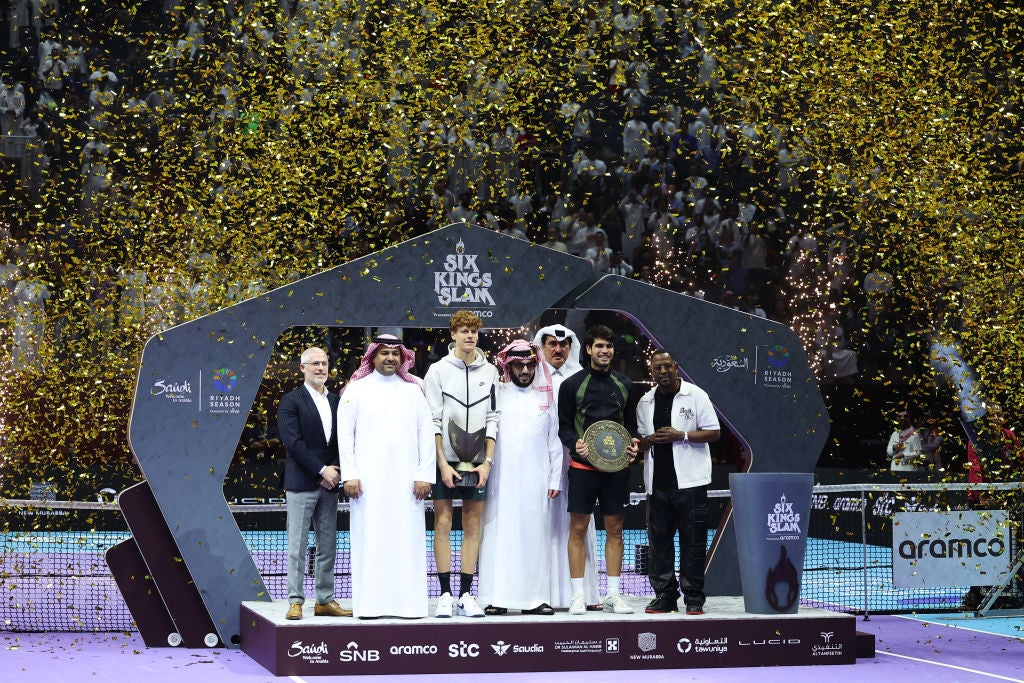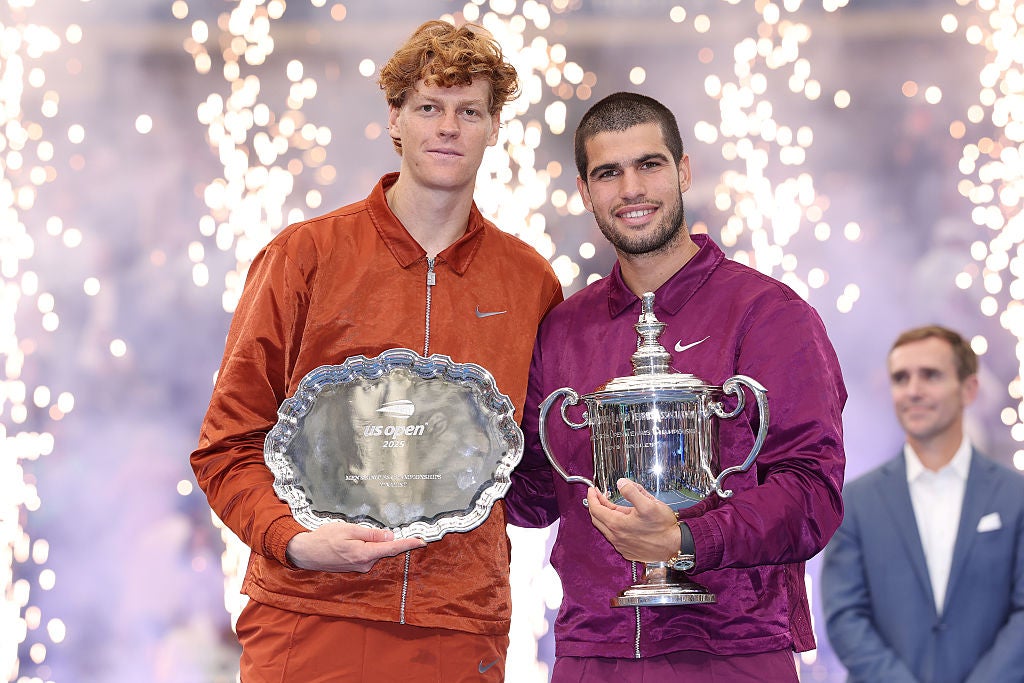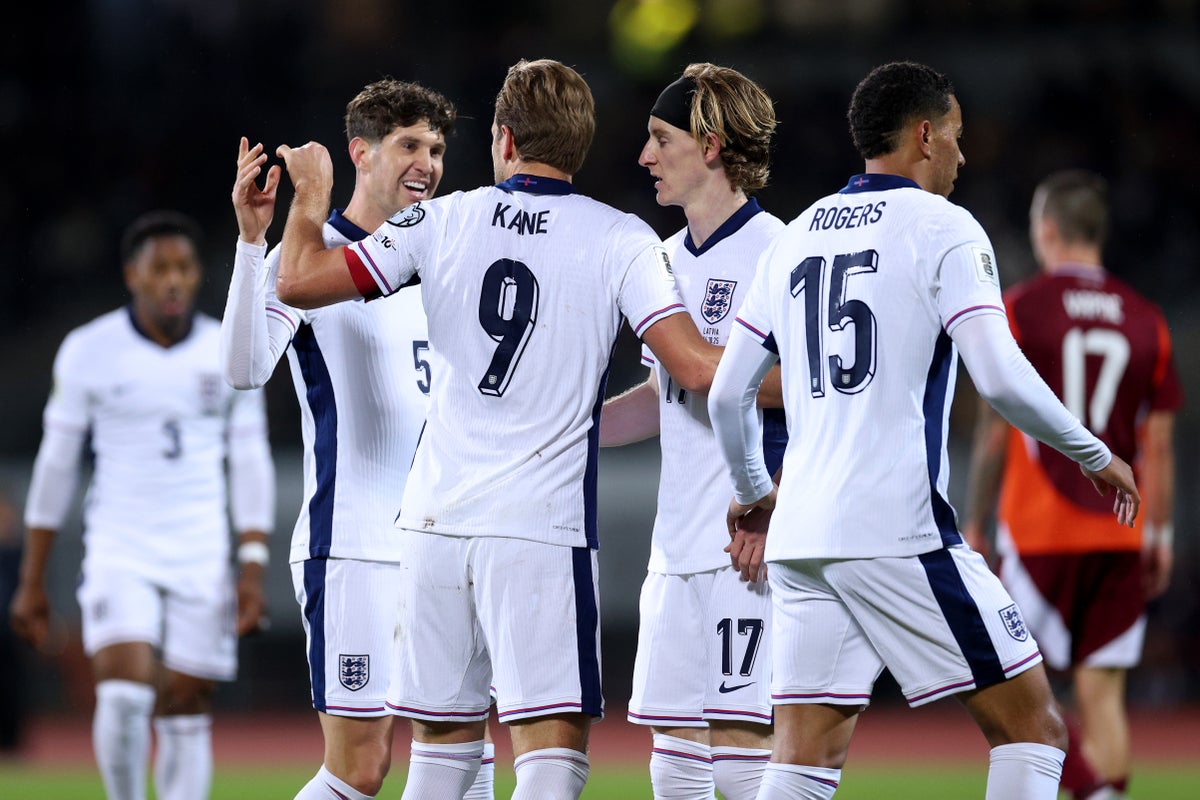At a time in the season where the annual debate over what to do about the overpacked and unrelenting tennis calendar swings around once more, it seems there is always room for a little more competition when it comes with a $6m cheque for the champion on the side. Carlos Alcaraz, Novak Djokovic and Jannik Sinner are among the players involved as the Six Kings Slam returns for its second year in Saudi Arabia, with the three-day exhibition in Riyadh offering $1m more to the winner than Alcaraz received when he triumphed at last month’s US Open, itself the biggest prize fund in grand slam history.
The Six Kings Slam has achieved what every other tournament on the ATP Tour could not and got Alcaraz, Djokovic and Sinner into the same draw for the first time outside of the grand slams this season. There are many reasons for that, of course, most of all Sinner’s three-month doping ban, Djokovic’s selective scheduling and a couple of injury withdrawals from Alcaraz, but hats off to the match-making skills of Turki Alalshikh, for the stars have managed to align themselves once again when it comes to Riyadh Season.
With a reported $1.5m guaranteed and an additional $4.5m up for grabs for winning the title, there are six million reasons why Alcaraz, Djokovic and Sinner are joined by Taylor Fritz, Alexander Zverev and Stefanos Tsitsipas in accepting the invitation from a Saudi state criticised over its human rights record. But money from Saudi Arabia’s Public Investment Fund already flows through the ATP Tour just as the country has invested billions in football, boxing, F1 and golf under a strategic plan to diversify its economy. Saudi Arabia will also host the WTA Finals next month for the second time, followed by the ATP’s Next Gen Finals. The Six Kings Slam can feel like a stepping stone to the Gulf hosting its own ATP Masters event.

Until then, the stakeholders involved in the Six Kings Slam will move and shift the optics to project whatever image they want (the tournament literally does this by advancing Djokovic to the semi-finals along with World No 1 Alcaraz, seemingly because they are the players with the most grand slam titles). Even the exhibition’s name is just words. This is not a slam. There are indeed six players, but one of the ‘kings’ is the ghost of Tsitsipas, ranked 24th in the world with a 55 per cent win rate on the ATP Tour this season.
But none of that matters. For now, Saudi Arabia gets its slice of men’s tennis, with potentially the same semi-final line-up from last month’s US Open followed by the juicier main course of another final between Alcaraz and Sinner. The invited players are happy, content to put complaints of an exhausting schedule to one side for a guaranteed fee that only requires a few days of work, unlike the never-ending 12-day, two-week Masters events the tours are so keen on. Netflix is on board, too, serving up its latest move into broadcasting live sports. Prepare for some dramatic montages telling you how important this all is.
There will be some good matches in a high-quality field, even if they won’t count on official head-to-head records. In terms of emotion, though, there won’t be anything that competes with the fairytale of Valentin Vacherot’s Shanghai Masters run and the win over his cousin Arthur Rinderknech, in what was a victory for the hundreds of players who go week to week chasing their dreams on the lower rungs of the tour.
It’s why the ATP doesn’t like exhibitions of this nature. They only benefit the players at the top, who are already cashing from the biggest sponsorships and commercial deals. They do nothing to help those struggling to make a career out of a life on tour, which is needed for a healthy ecosystem and competition. But the argument made by the players, and explained recently by Djokovic, is that they are also individual athletes. Sometimes, they need to make the best decisions for themselves. And despite Djokovic and Sinner struggling physically in Shanghai, and Alcaraz missing the tournament due to an ankle injury, all three are set to appear in Riyadh, receiving their own giant flower bouquets upon arrival.

An exhibition is an easy payday, after all, especially in Riyadh. Alcaraz has previously untangled himself from the apparent contradiction of criticising the tennis calendar while signing up to a number of exhibition tournaments throughout the year by explaining that he treats them differently from regular events. Duh, it’s an exhibition. Ever the showman, with a flair for risk-taking shots, the environment of exhibitions and the focus on entertainment can help Alcaraz to relax, according to his coach Juan Carlos Ferrero. Alcaraz, who only last month agreed with Iga Swiatek’s assessment that the season was “too long and too intense”, will make his return from an ankle injury before turning his attention to the Paris Masters and the ATP Finals - two events on the short list of elite tournaments he has yet to win by the age of 22.
Alcaraz skipped the brutal heat and humidity of Shanghai because of his injury, a decision that looked wise enough as top players toiled in the conditions, but it will see him lose 75 per cent of his share to the ATP’s Bonus Pool after missing his third mandatory event of the season. As Alcaraz looks set to top the year-end standings, his bonus would have been worth millions of dollars - but his cheque from the Six Kings Slam exhibition may end up covering that completely. It does, in effect, provide a bit of a loophole for a certain elite category of star to escape some of the mandatory commitments that many other players on the tour complain about. And it also reveals an obvious truth about what the top players want from their events outside of the four major grand slam tournaments: more money, fewer matches. It’s all out there in plain sight.

.jpeg)

















.jpg?width=1200&height=800&crop=1200:800)




.jpeg)













 English (US) ·
English (US) ·